English 


| Availability: | |
|---|---|
TANGPIN, one of the leading and professional fiber optic splitter manufacturers in China, has specialized in R&D, manufacturing, marketing, and sales of the optical splitter for over 15 years. We focus on quality and innovation, constantly pushing new products according to the markets.
So far, we have served over 1000 customers from 100+ countries and regions in the telecom industry. Our main customers are telecom carriers, ISPs (Internet Service Providers), and telecom engineering companies in Europe, Asia, Africa, and North America. TANGPIN optical splitter and service gained a lot of reputation.
The fiber optic splitter, optical coupler, also known as beam splitter, is a passive optical device that can split an imput optical signal on a fiber cable into multiple output signals at a certain splitting ratio. The fibre optical splitter is a key component in passive optical network(PON), especially widely used in GPON FTTH (fiber to the home), FTTC (fiber to the cabinet), and FTTB (fiber to the building) solutions.
Various packaging types including bare fiber type, mini steel tube type, ABS box type, cassette insertion type, tray type, and rack-mounted type can be chosen.
Classified by manufacturing technique, there are two commonly used types of optical splitters:
✔ Planar Lightwave Circuit Splitter (PLC Optical Splitter)
✔ Fused Biconical Taper Splitter (FBT Optical Splitter )
✔ Planar Lightwave Circuit Splitter (PLC Optical Splitter)
Planar Lightwave Circuit (PLC) splitter is a passive optical device based on based on planar lightwave circuit technology, which is available in a variety of split ratios. A typical PLC splitter consists of a PLC chip and an array of inputs and outputs, the number of which depends on the splitting ratio.
Planar Lightwave Circuit (PLC) splitter is a passive optical device based on based on planar lightwave circuit technology, which is available in a variety of split ratios. A typical PLC splitter consists of a PLC chip and an array of inputs and outputs, the number of which depends on the splitting ratio.

It also known as mini plc splitter, micro plc splitter or blockless plc splitter. The mini PLC splitter is very similar to the bare fiber splitter, while the former doesn't need fiber optic fusion during installation. This steel tube splitters are commonly used in fiber optic distribution box(ODB), optical patch panel and fiber joint splice closure.
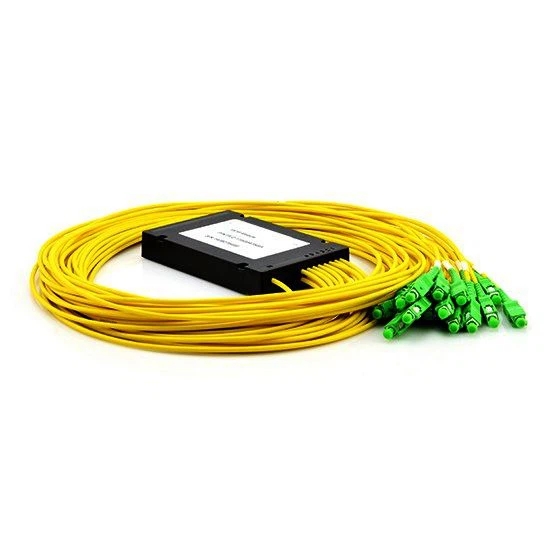
The ABS splitter is packed by a ABS box, which has a solid protection for internal optical components and fiber cables. It is universally used in fiber optical terminal boxes for GPON FTTx Solutions.

Also called insert type splitter, insertion cassette splitter, it is packaged With mini plug-in style, it can be installed in the cassette splitter distribution box and splice cabinet.

The Rack Mounted PLC Splitters consist of the PLC splitters and the metal enclosure. Well-packaged in a 19-inch rack mount panel, the rack PLC splitters suit for the indoor or outdoor applications in FTTx projects, CATV or data communication centers.

Bare Fiber PLC Splitter
There is no fiber optic connectors terminated on the bare fiber PLC splitter ends. That's to say all ends of this splitter is bare fiber, which is easily spliced and takes the least space while reducing installation costs. It is widely installed informal splice boxes and splice boxes in passive optical networks.

Tray Type PLC Splitter
The Tray type PLC splitters are widely installed in ODF racks, standard network cabinets, standard integrated cabinets and other series of products. Bare fiber type /steel tube type /box type optical splitter can be installed in the tray and flexibly configured as required.
(Ps. Fiber optic splitter box is usually used with 2mm or 3mm outer diameter cable, while the other is normally used in combination with 0.9mm outer diameter cables.)
✔ 1xN PLC Splitters (N=2, 4, 8, 16, 32, 64)
✔ 2xN PLC Splitters (N=2, 4, 8, 16, 32, 64)

1x2 SC/UPC PLC splitter

1x4 SC/UPC PLC splitter

1x8 SC/UPC PLC splitter

1x16 SC/APC PLC splitter

1x32 SC/APC PLC splitter

1x64 SC/APC PLC splitter

2x2 PLC ST/APC splitter

2x8 SC/APC PLC splitter

2x16 LC/APC PLC splitter
(Ps. A variety of split ratios, 1:4, 1:8, 1:16, 1:32, 1:64, 2:4, 2:8, 2:16, 2:32, 2:64 are available in Tangpin.)
✔ Fused Biconical Taper Splitter (FBT Optical Splitter )
Fused Biconical Taper Splitter (FBT splitter) is based on traditional biconical taper coupler technology, its split ratio is unequal. With the development of this technology, FBT separators are of very good quality and can be deployed in a cost-effective manner. FBT splitters are widely accepted and used in passive networks, especially for smaller split configurations.

Steel tube FBT Splitter
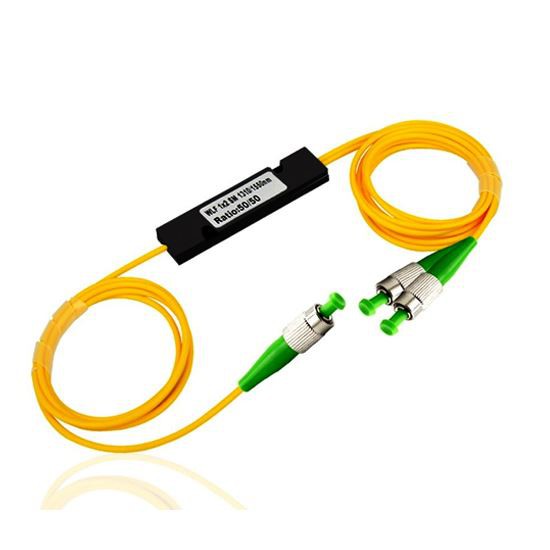
ABS Module FBT Splitter

Rack Mount FBT Splitter
The splitting ratio of the FBT splitter is not even, which can be customized. There are several types of FBT splitters: 1x2, 1x3, 1x4, 1x8, 1x16 & 1x32 FBT splitters can be customized.

1:2 SC/APC FBT Coupler

1:3 SC/UPC FBT Coupler

1:4 FC/UPC FBT Coupler
The above three types of fbt splitters are commonly used. Kindly note the performance is realiable up to 1:8. For larger splits, the reliability will be an issue.

Single-Window FBT Coupler
Working from 1310nm to1550nm,and they have operation bandwidth of 40nm around its central wavelength.

Dual-Window FBT Coupler
The dual-window FBT couplers have dual windows of 1310 nm and 1550 nm, minimal excess loss, long-term stability and high directivity.

Triple-Window FBT Coupler
The FBT Fiber Optic Splitter Triple Window is operating at 1310nm,1490nm &1550nm or as per requirement.
According to different fiber optic connectors terminated on the fiber input & output ends, the optical splitters can be devided into SC splitters, LC splitters, ST splitter & FC splitter. Among them SC splitter and LC splitter are commonly used.

ST/APC splitter

LC/UPC splitter

FC/APC splitter
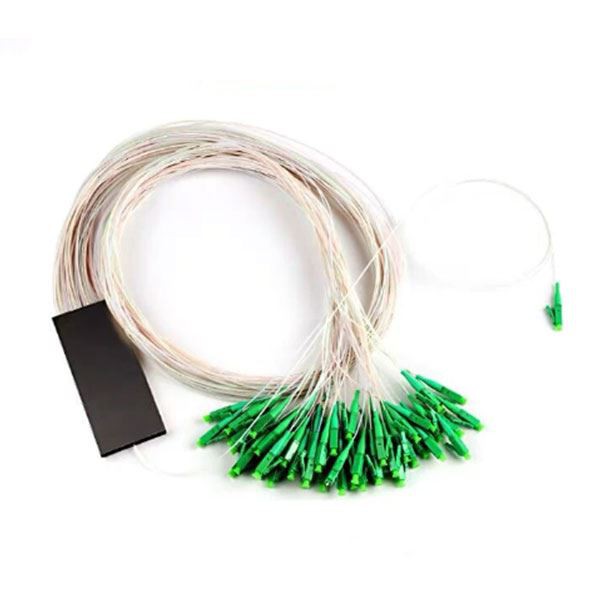
LC/APC splitter

SC/APC splitter

FC/UPC splitter
(Ps. Different connectors like SC/APC, SC/UPC, LC/APC, LC/UPC, FC/APC, FC/UPC, ST/APC, ST/UPC of various fiber lengths ranging from 0.5meter to hundreds of meters can be customized.)
The optical splitter can be classified into 2 types, singlemode(SM) optical splitter and multimode(MM) optical splitter according to the different tramsimission mediums. The SM splitter is capable of operation for 1310nm and 1550nm, 9/125 (OS1 & OS2) fibers are available. While MM splitter is for 850nm and 1310nm wavelength, both 50/125 and 62.5/125 (OM1, OM2, OM3 and OM4) fibers are available.

Singlemode (OS1/OS2) Splitter

Multimode (OM1/OM2) Splitter

Multimode (OM3/OM4)Splitter
(Ps. The input/output cable color is depened on the fiber mode, for OS1/OS2, the input/output cable color is yellow, OM1/OM2 is orange, while OM3/OM4 is aqua. Fiber optic splitter box is usually used with 2mm or 3mm outer diameter cable, while the other is normally used in combination with 0.9mm outer diameter cables.)
● Telecom level products with high reliability and super stability ensure uninterrupted network connection.
● Well-trained staff, powerful R&D and technical team support.
● Competitive factory-direct-sales price to help you save at least 30% of the costs
● Flexible MOQ and free samples are available.
● A strong monthly supply capacity ensures a very short lead-time and quick delivery.
● 24-hour online to offer prompt feedback on professional pre-sales consultation, inquiry quotation, remote technical support, and after-sales service.
TANGPIN, established in 2005, is one of the earliest and biggest manufacturers of fiber optic splitters in Shanghai, China. We are with more than 15 years of vendor experience for customers.
Competitive factory-direct-sales price to help customers save at least 30% of the costs
Telecom level optical splitters with high reliability and super stability ensure uninterrupted network connection.
Various packing types of different configurations can be customized. Even the logo can be printed.
Free optical splitter samples are available, and customers only need to pay the sample freight.
There is no MOQ for standard and regular fiber optic splitters.
A strong monthly supply capacity of over 280,000 ensures a very short lead-time and quick delivery.
The warranty lasts for 3 years from the date customer received the order.
We are 24-hour online to offer prompt feedback on professional pre-sales consultation, inquiry quotation, remote technical support, and after-sales service.
We adopt advanced manufacturing facilities and testing equipment for optical splitters, like optical cutting fiber machine, grinding machine, coupling equipment, UV solidifying oven, high and low temperature tester, 3D interferometer, insertion loss, and return loss tester, etc.

● Over 2600 square meters of modern manufacturing factory
● 10 non-dust production lines for optical splitters
● A powerful R&D and technical team of 26 technicians, a strong QC team of 10 engineers, and 180 well-trained staff
● 16years manufacturing experience in Planar Lightwave Circuit Splitters Series (PLC Splitter, PLC Chips, Fiber ● Array, and V-Groove), and Fused Biconical Couplers.
● The current daily production capacity for optical splitter is over 10,000 Pcs.
● ISO9001
● RoHS
● We adopt a very strict QC procedure that each unit of our optical splitters will go through a 3-layer QC procedure:
1. Raw material checking before production
2. Stability and performance testing after production
3. Packing checking before shipment
● All our products will be sterilized before production and before delivery.
● Remote technical support and 24hrs online consultation will be provided after-sales.
● We ensure every piece of our fiber optic products is with excellent performance and appearance.
TANGPIN Tech has worked with over 1000+ customers, and over 60% of our customers are telecom carriers, internet service providers, and telecom engineering companies.
In our domestic market, we've contracted some FTTH projects of China Mobile and China Telecom, and won many tenders, like Zhengzhou Metro station project, Hunan Radio, and Television Broadcast Network projects & University town Project, and so on.
Our overseas customers are mainly from Southeast Asia, Europe, and African, such as Telkom, T-Mobile, AsiaCell, AWCC, PMCL, FiberNet, etc. We are very proud of having been offering these world-leading telecom companies with stable high-quality optic splitters, and we sincerely hope we can go further and grow together with our partners.

Θ What's the difference between PLC splitter and FBT coupler?
Θ How to calculate the max allowable insertion for an optical splitter?
Θ What's the difference between FBT and PLC splitters on insertion loss?
Θ What's the difference between bare fiber PLC splitter and steel tube PLC splitter ?
Θ Is this blockless type PLC splitter can be used for fiber optic splice closure?
Θ What is an optical splitter and what are the important technical indicators?
A fiber optic splitter also called an optical splitter, is a passive power distribution device that can split or divide a light beam into multiple light beams by a certain ratio. The optical splitter plays a crucial role in the passive optic network (PON) systems, like GPON, FTTH, FTTB, FTTC, etc.
The device contains multiple input and output ends. Whenever the fiber beam transmission in a network needs to be divided, fiber optic splitter can be implemented for the convenience of network interconnections. As one of the most important passive devices in the optical fiber link, the optical splitter, an optical fiber tandem device with many input and output terminals, plays a crucial role in the optic network systems to connect the main distribution frame and the terminal equipment and to branch the optical signal.

A fiber optic splitter is a passive optical contrivance, generally, the basic working principle of the optical splitter is to distribute or split a light signal into two or more light signals by a certain ratio through the fiber.

When the light transmits signals in a single-mode fiber, its energy can’t entirely concentrated in the fiber core, thus a small amount of energy can be spread via the cladding of fiber. In other words, if two optical fibers are close enough, the transmitting light in an optical fiber can enter into another fiber, which make the reallocation technique of fiber signal achieved in multi fibers.
There are two types of optical splitter, PLC splitter and FBT splitter, so there are two ways of working modes. PLC splitter is based on planar lightwave circuit technology, and it’s composed of an optical splitter chip and an optical fiber array at both ends. The splitter chip is the core that can divide one incoming signal into multiple output signals.
While FBT splitter, or coupler, is two or more fibers are joined together by melting using fusion technology. The changes of the splitting ratio are monitored in real-time. Once the splitting ratio achieves the requirements, the taper process will end. The input port is one fiber, and the multi-outputs are in the other side.
PLC means Planar Lightwave Circuit. It's a planar arrangement of waveguides on a substrate, which is widely used in fiber optical networks. The PLC splitter is of uniform splitting ratio with high reliability.
FBT also called Fused Bicnoic Taper, is a traditional and mature technology to weld several fibers together closely. The FBT splitter is protected by a steel tube or an ABS module because the fused fibers are very fragile.
Kindly check the differences listed below:
parameters | PLC splitter | FBT splitter |
Manufacturing unique | New technique | Traditional technique |
 |  | |
Production process | Complicated | Easy |
Wavelength | 1260nm~1650nm | 850nm, 1310nm & 1550nm |
Splitting ratio | Equal for all branches | Customizable |
Reliable splits | 1x64 (equal to all branches providing high reliability) | 1x8 (can be larger with a high failure rate) |
Operating tempraturee | -40C to 85 °C | -5 °C to 75 °C |
Cost | Higher price | Lower price |
Failure rate | High | Low |
● Low insertion loss
● Low back reflection
● Low PDL (polarization dependent loss)
● Good channel-to-channel uniformity
● High stability, super reliability, the low failure rate
● Reliable Environmentally and mechanically stability
● Compact configuration and smaller occupation space
● Compliant with Telcordia GR-1209-Core Reliability Test
● Compliant with Telcordia GR-1221-Core Reliability Test
● Wide range of operating wavelength (1260nm~1650nm)
● Simple and easy installation for a variety of fiber optic distribution box, distribution frame and fiber optic cabinets.
A qualified PLC splitter should be compliant with The GR-1209 standard. There are 5 main factors that determine the quality, they are optical bandpass, insertion loss, return loss, uniformity & directivity.
The insertion loss can be tested by a power meter and the reference power level can be obtained when measuring all the outputs of the splitter. In a similar manner, we can use a return loss meter to test the return loss. The way is to connect the return loss meter with the input port of the splitter and combine the outputs to a non-reflective index matching gel.
The directivity of the splitter can be measured and the way is similar to the insertion loss test. While the power meter and light source are connected to each of the input ports of two output ports.
The maximum allowable insertion loss can be calculated by the following formula:
1×N Optical Splitter | 0.8 + 3.4 log2N |
2×N Optical Splitter | 1.0 + 3.4 log2N |
(Note: "N" refers to the number of output ports.)
Here offer you the insertion loss reference table for these 2 types of splitters.

FBT IL Table

PLC IL Table
Fiber optic splitter is the device to separate or combine optical signals to realize optical signal power splitting. It's widely used in the OLT node, FTTH point in optic network PON (GPON/EPON) system and FTTx (FTTH, FTTB, FTTC, FTTA) solutions, CATV network, video transmission system, LAN, WAN and metro networks.
It has a stainless tube package which provides strong fiber protection, and its fiber ends are all terminated with fiber optic connectors. There is no need for fiber splicing during installation. Steel Tube PLC Splitter is mainly used for different connections over distribution boxes or network cabinets.

ABS splitter has a plastic ABS box to protect the splitter to adapt to different installation environments and requirements. Common splitter modules are 1×4, 1×8, 1×16, 1×32, 1×64, 2×4, 2×8, 2×16, 2×32. It is widely used with outdoor fiber distribution box for PON, FTTH, FTTX, PON, GOPN networks.

Plug-in splitter is usually installed in the wall mount FTTH box for fiber optic signal distribution. Using the plug-in type splitter saves time and space but still provides reliable protection for the fiber optic splitter.
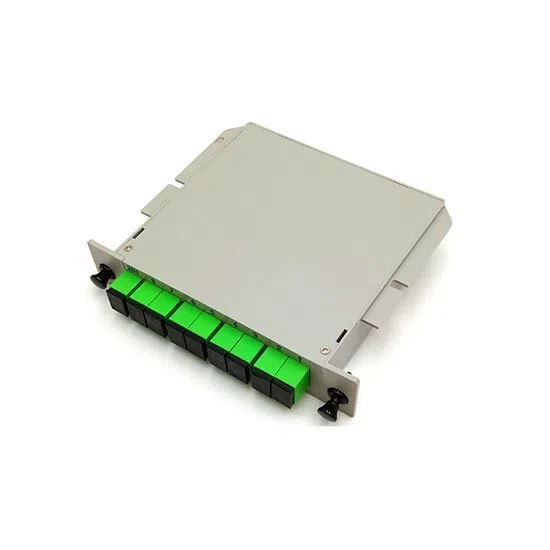
Rack-mount splitter can be used for both indoor and outdoor applications in FTTx projects, CATV or data communication centers. It uses the 19-inch rack unit standard to contain the splitter inside a rack unit.

Bare fiber splitter has no connector at the bare fiber ends. It can be spliced with other optical fibers in the pigtail cassette, test instrument and WDM system, which minimizes the space occupation.

Tray type splitter can be regarded the fiber enclosure which contains fiber splitter inside a enclosure. It is often directly installed in optical fiber distribution box or optical distribution frame. Tray type splitter is an ideal solution for splitting at the places that are near OLT or ONU.

PLC splitter has better performances and fewer limitations, while FBT splitter is less expensive in the smaller ratio to save more for the budgets. When choosing a fiber optic splitter, you should consider the costs and applications.
The bare fiber splitter is a type of splitters without connectors. Its input and output are designed with bare fibers (generally use ribbon fiber to output). Bare fiber splitters are used for small spaces that can be easily placed in a formal joint boxes and splice closure. In order to facilitate welding, it does not need specially designed for space reserved.
Fiber optical splitter is usually being installed in outdoor enclosures. Their function is to distribute or combine optical signals to mutiple homes and businesses.
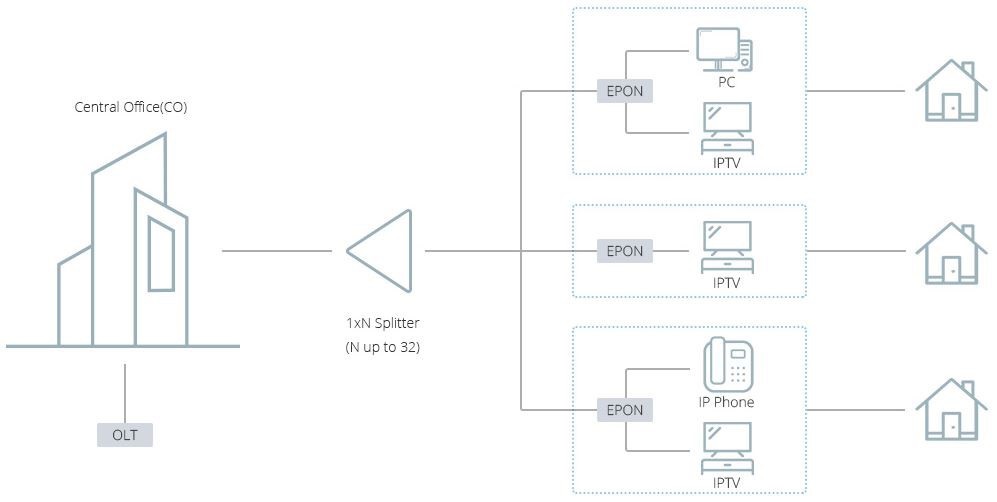
Yes, this steel tube PLC splitter can be installed in fiber optic splice closure easily to provide FTTH signal distribution. It also can be installed in fiber optic distribution boxes.
An optical splitter distributes the transmitted optical signal in one optical fiber to multiple optical fibers. There are various allocation forms, 1×2, 1×4, 1×N, or 2×4, M×N. directivity, PDL polarization loss, temperature loss etc. are also parameters that affect the performance of the optical splitter...
With the continuous development of PON technology, the application of passive optical network systems will become more and more common in the future. As one of the indispensable components of the PON network architecture, optical splitters may face increasing demand for use...
Fiber optical splitters are playing an increasingly important role in today's optical networks. From the FTTx system to the traditional optical network, it not only enables many users to share an optical fiber interface, but also helps users to expand the functions of the optical network circuit to the greatest extent. With the continuous development of modern technology, various fiber optic splitters appear on the market.
PLC planar optical waveguide splitter is composed of pigtail, core chip, optical fiber array, shell (ABS box, steel tube), connector and optical cable. Based on the planar optical waveguide technology, the optical input is evenly converted into multiple optical outputs with a precise optical coupling process. Our company adopts high-quality PLC core, advanced independent production and manufacturing technology and good quality assurance, to continuously provide domestic and foreign users with high-quality optical performance, stability and reliability.
Optical insertion loss refers to the loss of optical signals caused by the insertion of components such as connectors or splices in a fiber optic system. The optical splitter is a device with the largest attenuation in the PON system. In order to save the power budget of the PON system, the insertion loss from the fiber splitter needs to be minimized.
Yes, we can offer. But for splitting ratio 20:80, it’s FBT splitter, not PLC Splitter. The former offers adjustable splitting ratio, while the latter offers equal split ratios for all branches.
We are the manufacturer with factory base in Zhejiang. Here's the link to a virtual tour of our factory: https://www.shtptelecom.com/factory-tour
1 week for Sample and 2-4 weeks for mass production.
1: We arrange the shipping, by sea or by air. By air is express courier - FedEx/ DHL/UPS/TNT/EMS. By sea is to ship them by our agent company.
2: Clients assign a logistic company for the shipping, we follows their instructions and finish the delivery.
We can offer free samples of regular splitters, but customers have to afford the sample shipping fee.
Sure, no hesitate to tell us your ideas.
We support EXW, FOB and CIF terms of trade
Our MOQ Lan cable 100boxes,patch cord cable 1000pcs.Of course, if we have stock. We can offer a smaller quantity.
At the same price, our quality is better; at the same quality, our price is more favorable.
Welcome to join us. We have a professional technical team and R&D capabilities to meet your needs.